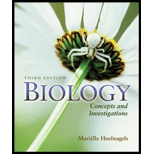
Biology: Concepts and Investigations
3rd Edition
ISBN: 9780073525549
Author: Mariëlle Hoefnagels Dr.
Publisher: McGraw-Hill Education
expand_more
expand_more
format_list_bulleted
Concept explainers
Question
Chapter 18, Problem 2WIO
Summary Introduction
To enlist:
Some examples of protist diversity and to explain how different protist groups obtain energy, their movement, and differences in protist appearance.
Concept introduction:
Protists are the first eukaryotic cells evolved. Protists are formed by the endosymbiosis of aerobic cells and cyanobacteria in other cells and established a mutual relationship between them. The protists that exhibit the chlorophyll a and chlorophyll b and have the cell wall made up of the cellulose are called green algal species.
Expert Solution & Answer
Want to see the full answer?
Check out a sample textbook solution
Students have asked these similar questions
Explain in a small summary how:
What genetic information can be obtained from a Punnet square? What genetic information cannot be determined from a Punnet square?
Why might a Punnet Square be beneficial to understanding genetics/inheritance?
In a small summary write down:
Not part of a graded assignment, from a past midterm
Chapter 18 Solutions
Biology: Concepts and Investigations
Ch. 18.1 - What features define the protists?Ch. 18.1 - Prob. 2MCCh. 18.1 - Why are evolutionary biologists interested in...Ch. 18.2 - Prob. 1MCCh. 18.2 - Prob. 2MCCh. 18.2 - List and describe the characteristics of the major...Ch. 18.3 - What mode of nutrition do the slime molds and...Ch. 18.3 - Prob. 2MCCh. 18.3 - Prob. 3MCCh. 18.4 - Prob. 1MC
Ch. 18.4 - Prob. 2MCCh. 18.4 - List three diseases caused by flagellated...Ch. 18.4 - Compare and contrast amoebae, foraminiferans, and...Ch. 18.4 - How do ciliates move and eat?Ch. 18.4 - Prob. 6MCCh. 18.5 - Prob. 1MCCh. 18.5 - What features unite some of the major lineages of...Ch. 18.6 - Use the food chain in figure 18.21a to explain why...Ch. 18.6 - Prob. 2MCCh. 18 - Which of the following is NOT a characteristic of...Ch. 18 - Suppose you are studying a protist under a...Ch. 18 - Some protist lineages arose from secondary...Ch. 18 - Prob. 4MCQCh. 18 - Why are DNA sequences useful in the classification...Ch. 18 - Explain why evolutionary biologists are interested...Ch. 18 - 2. List some examples of protist diversity. How do...Ch. 18 - Describe the relationship between nutrient...Ch. 18 - Explain why the fossil record for diatoms is much...Ch. 18 - How is it adaptive for a red alga to have pigments...Ch. 18 - Prob. 6WIOCh. 18 - Prob. 7WIOCh. 18 - Prob. 8WIOCh. 18 - Give three examples of protists for which the...Ch. 18 - Suppose someone hands you a microscope and a...Ch. 18 - Prob. 1PITCh. 18 - Molecular data have changed protist...Ch. 18 - Prob. 3PIT
Knowledge Booster
Learn more about
Need a deep-dive on the concept behind this application? Look no further. Learn more about this topic, biology and related others by exploring similar questions and additional content below.Similar questions
- Noggin mutation: The mouse, one of the phenotypic consequences of Noggin mutationis mispatterning of the spinal cord, in the posterior region of the mouse embryo, suchthat in the hindlimb region the more ventral fates are lost, and the dorsal Pax3 domain isexpanded. (this experiment is not in the lectures).a. Hypothesis for why: What would be your hypothesis for why the ventral fatesare lost and dorsal fates expanded? Include in your answer the words notochord,BMP, SHH and either (or both of) surface ectoderm or lateral plate mesodermarrow_forwardNot part of a graded assignment, from a past midtermarrow_forwardNot part of a graded assignment, from a past midtermarrow_forward
- please helparrow_forwardWhat does the heavy dark line along collecting duct tell us about water reabsorption in this individual at this time? What does the heavy dark line along collecting duct tell us about ADH secretion in this individual at this time?arrow_forwardBiology grade 10 study guidearrow_forward
arrow_back_ios
SEE MORE QUESTIONS
arrow_forward_ios
Recommended textbooks for you
 Human Anatomy & Physiology (11th Edition)BiologyISBN:9780134580999Author:Elaine N. Marieb, Katja N. HoehnPublisher:PEARSON
Human Anatomy & Physiology (11th Edition)BiologyISBN:9780134580999Author:Elaine N. Marieb, Katja N. HoehnPublisher:PEARSON Biology 2eBiologyISBN:9781947172517Author:Matthew Douglas, Jung Choi, Mary Ann ClarkPublisher:OpenStax
Biology 2eBiologyISBN:9781947172517Author:Matthew Douglas, Jung Choi, Mary Ann ClarkPublisher:OpenStax Anatomy & PhysiologyBiologyISBN:9781259398629Author:McKinley, Michael P., O'loughlin, Valerie Dean, Bidle, Theresa StouterPublisher:Mcgraw Hill Education,
Anatomy & PhysiologyBiologyISBN:9781259398629Author:McKinley, Michael P., O'loughlin, Valerie Dean, Bidle, Theresa StouterPublisher:Mcgraw Hill Education, Molecular Biology of the Cell (Sixth Edition)BiologyISBN:9780815344322Author:Bruce Alberts, Alexander D. Johnson, Julian Lewis, David Morgan, Martin Raff, Keith Roberts, Peter WalterPublisher:W. W. Norton & Company
Molecular Biology of the Cell (Sixth Edition)BiologyISBN:9780815344322Author:Bruce Alberts, Alexander D. Johnson, Julian Lewis, David Morgan, Martin Raff, Keith Roberts, Peter WalterPublisher:W. W. Norton & Company Laboratory Manual For Human Anatomy & PhysiologyBiologyISBN:9781260159363Author:Martin, Terry R., Prentice-craver, CynthiaPublisher:McGraw-Hill Publishing Co.
Laboratory Manual For Human Anatomy & PhysiologyBiologyISBN:9781260159363Author:Martin, Terry R., Prentice-craver, CynthiaPublisher:McGraw-Hill Publishing Co. Inquiry Into Life (16th Edition)BiologyISBN:9781260231700Author:Sylvia S. Mader, Michael WindelspechtPublisher:McGraw Hill Education
Inquiry Into Life (16th Edition)BiologyISBN:9781260231700Author:Sylvia S. Mader, Michael WindelspechtPublisher:McGraw Hill Education

Human Anatomy & Physiology (11th Edition)
Biology
ISBN:9780134580999
Author:Elaine N. Marieb, Katja N. Hoehn
Publisher:PEARSON

Biology 2e
Biology
ISBN:9781947172517
Author:Matthew Douglas, Jung Choi, Mary Ann Clark
Publisher:OpenStax

Anatomy & Physiology
Biology
ISBN:9781259398629
Author:McKinley, Michael P., O'loughlin, Valerie Dean, Bidle, Theresa Stouter
Publisher:Mcgraw Hill Education,

Molecular Biology of the Cell (Sixth Edition)
Biology
ISBN:9780815344322
Author:Bruce Alberts, Alexander D. Johnson, Julian Lewis, David Morgan, Martin Raff, Keith Roberts, Peter Walter
Publisher:W. W. Norton & Company

Laboratory Manual For Human Anatomy & Physiology
Biology
ISBN:9781260159363
Author:Martin, Terry R., Prentice-craver, Cynthia
Publisher:McGraw-Hill Publishing Co.

Inquiry Into Life (16th Edition)
Biology
ISBN:9781260231700
Author:Sylvia S. Mader, Michael Windelspecht
Publisher:McGraw Hill Education
Biodiversity hotspots and functional diversity; Author: Stockholm Resilience Centre TV;https://www.youtube.com/watch?v=Gr_eIsFOKr4;License: Standard Youtube License